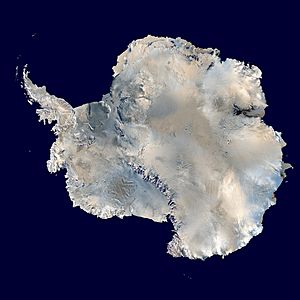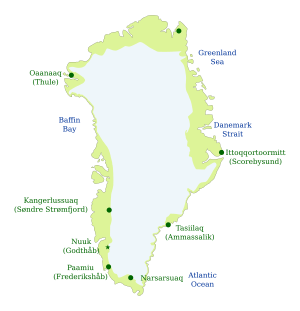Ice sheet facts for kids

Imagine a giant, thick blanket of ice covering a huge part of a continent! That's what an ice sheet is. It's a massive area of glacier ice that spreads out over more than 50,000 square kilometers (about 19,000 square miles). You might also hear it called a continental glacier. Right now, there are only two main ice sheets on Earth: one in Antarctica and another in Greenland.
Ice sheets are truly enormous! They are much bigger than ice shelves (which are floating ice platforms) or regular mountain glaciers. Smaller ice masses, covering less than 50,000 square kilometers, are called ice caps. The ice in an ice cap usually forms from several glaciers that flow into it.
Contents
The Antarctic Ice Sheet
The Antarctic ice sheet is the largest single mass of ice on our planet. It covers almost 14 million square kilometers (about 5.4 million square miles). This is roughly the size of the United States and Mexico combined! It holds an incredible 30 million cubic kilometers of ice.
Earth's Freshwater Storage
About 90% of all the fresh water on Earth's surface is locked away in the Antarctic ice sheet. If this entire ice sheet were to melt, it would cause global sea levels to rise by a massive 58 meters (about 190 feet). That's taller than a 15-story building!
How the Antarctic Ice Sheet Formed
This giant ice sheet first started forming a very long time ago, in the early Oligocene epoch. Over millions of years, it grew and shrank many times. By the Pliocene epoch, it had grown to cover almost all of Antarctica, becoming the huge ice sheet we see today.
The Greenland Ice Sheet
The Greenland ice sheet covers about 82% of the surface of Greenland. It's the second-largest ice sheet in the world.
Melting Ice in Greenland
Satellite images from NASA show that the Greenland ice sheet is melting quite fast. It loses about 239 cubic kilometers (about 57 cubic miles) of ice every single year. If all of the Greenland ice sheet melted, it would cause global sea levels to rise by 7.2 meters (about 23.6 feet).
Greenland's Unique Formation
Unlike the Antarctic ice sheet, the Greenland ice sheet didn't start forming until the late Pliocene. But once it began, it grew very quickly. This fast formation had an interesting effect: it helped preserve fossils of plants that once grew on Greenland much better than in Antarctica.
Images for kids
-
Aerial view of the ice sheet on Greenland's east coast
See also
 In Spanish: Indlandsis para niños
In Spanish: Indlandsis para niños



